Impact of Internal Solitary Waves on Marine Suspended Particulate Matter: A Review
Abstract
1. Introduction
2. Observation Techniques for ISWs and Suspended Particulate Matter
3. The Interaction Between SPM and ISWs
3.1. The Dynamic Characteristics of SPM in Fluids
3.2. Distribution and Transport of SPM in the Ocean
3.3. The Process of SPM Variation Under the Influence of ISWs
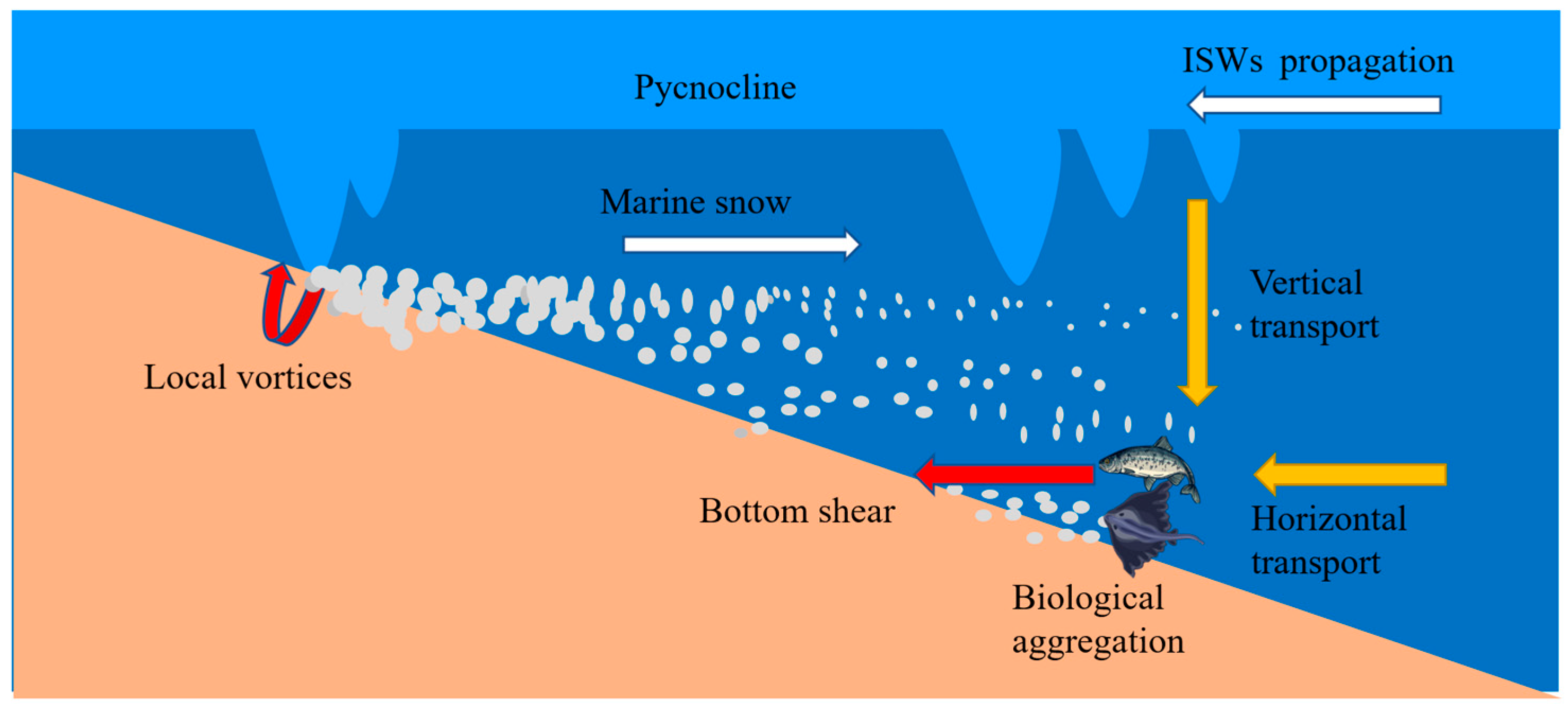
3.4. Interaction Between ISWs and SPM in the Northern South China Sea
4. Conclusions and Future Outlooks
- (1)
- Current models are still insufficient in capturing the nonlinear and unsteady interactions between ISWs and SPM. Future research should focus on developing Lagrangian–Eulerian coupled models, in which the wave-induced flow field is solved within an Eulerian framework, while the motion of individual particles or particle clouds is tracked using a Lagrangian approach. This method can explicitly account for particle inertia, size distribution, and settling behavior under wave-induced turbulence and density stratification.
- (2)
- There is an urgent need to develop more reasonable parameterization schemes to describe sediment resuspension, flocculation, and settling during shear and turbulence processes induced by ISWs. These parameterizations should be validated using high-resolution field and experimental data, especially during the steepening and breaking phases of ISWs—periods when sediment transport is most active.
- (3)
- Stronger collaboration with observational efforts is essential. Field observations should aim to provide key datasets with high temporal and spatial resolution, such as near-bottom current velocity, turbulence intensity, SPM concentration, and interface instability, to support model validation. In turn, model outputs can guide the timing and spatial layout of future observations, thereby improving the efficiency and focus of field surveys.
- (4)
- Although significant progress has been made in the South China Sea, future research should also focus on other regions with complex topography or ecological sensitivity, such as estuaries, deltas, and continental slopes, to further assess the ecological and geomorphological impacts of ISW–SPM interactions in diverse settings.
Author Contributions
Funding
Data Availability Statement
Acknowledgments
Conflicts of Interest
References
- Lamb, K.G. Internal Wave Breaking and Dissipation Mechanisms on the Continental Slope/Shelf. Annu. Rev. Fluid. Mech. 2014, 46, 231–254. [Google Scholar] [CrossRef]
- Boegman, L.; Stastna, M. Sediment Resuspension and Transport by Internal Solitary Waves. Annu. Rev. Fluid. Mech. 2019, 51, 129–154. [Google Scholar] [CrossRef]
- Ransom, B.; Shea, K.F.; Burkett, P.J.; Bennett, R.H. Comparison of pelagic and nepheloid layer marine snow: Implications for carbon cycling. Mar. Geol. 1998, 150, 39–50. [Google Scholar] [CrossRef]
- Marttila, H.; Klove, B. Spatial and temporal variation in particle size and particulate organic matter content in suspended particulate matter from peatland-dominated catchments in Finland. Hydrol. Process 2015, 29, 1069–1079. [Google Scholar] [CrossRef]
- Lamb, K.G. Particle transport by nonbreaking, solitary internal waves. J. Geophys. Res. Oceans 1997, 102, 18641–18660. [Google Scholar] [CrossRef]
- Johnson, D.R.; Weidemann, A.; Pegau, W.S. Internal tidal bores and bottom nepheloid layers. Cont. Shelf Res. 2001, 21, 1473–1484. [Google Scholar] [CrossRef]
- McPhee-Shaw, E.E.; Sternberg, R.W.; Mullenbach, B.; Ogston, A.S. Observations of intermediate nepheloid layers on the northern California continental margin. Cont. Shelf Res. 2004, 24, 693–720. [Google Scholar] [CrossRef]
- Aghsaee, P.; Boegman, L.; Diamessis, P.J.; Lamb, K.G. Boundary-layer-separation-driven vortex shedding beneath internal solitary waves of depression. J. Fluid. Mech. 2012, 690, 321–344. [Google Scholar] [CrossRef]
- Bourgault, D.; Morsilli, M.; Richards, C.; Neumeier, U.; Kelley, D.E. Sediment resuspension and nepheloid layers induced by long internal solitary waves shoaling orthogonally on uniform slopes. Cont. Shelf Res. 2014, 72, 21–33. [Google Scholar] [CrossRef]
- Gardner, W.D.; Richardson, M.J.; Mishonov, A.; Biscaye, P.E. Global comparison of benthic nepheloid layers based on 52 years of nephelometer and transmissometer measurements. Prog. Oceanogr. 2018, 168, 100–111. [Google Scholar] [CrossRef]
- Chen, T.; Liu, F.; Li, Z.; Shan, H.; Liu, H.; Quan, Y.; Zhou, Z.; Tan, Z.; Jia, Y. Global Trends and Prospects of Nepheloid Layers: A Comprehensive Bibliometric Review. Water 2023, 15, 1067. [Google Scholar] [CrossRef]
- Perry, R.B.; Schimke, G.R. Large-amplitude internal waves observed off the northwest coast of Sumatra. J. Geophys. Res. 1965, 70, 2319–2324. [Google Scholar] [CrossRef]
- Ramp, S.R.; Tang, T.Y.; Duda, T.F.; Lynch, J.F.; Liu, A.K.; Chiu, C.S.; Bahr, F.L.; Kim, H.R.; Yang, Y.J. Internal solitons in the northeastern South China Sea-Part I: Sources and deep water propagation. IEEE J. Ocean. Eng. 2004, 29, 1157–1181. [Google Scholar] [CrossRef]
- Yang, Y.J.; Tang, T.Y.; Chang, M.H.; Liu, A.K.; Hsu, M.K.; Ramp, S.R. Solitons northeast of Tung-Sha Island during the ASIAEX pilot studies. IEEE J. Ocean. Eng. 2004, 29, 1182–1199. [Google Scholar] [CrossRef]
- Cai, S.; Xie, J.; He, J. An Overview of Internal Solitary Waves in the South China Sea. Surv. Geophys. 2012, 33, 927–943. [Google Scholar] [CrossRef]
- Guo, C.; Chen, X. A review of internal solitary wave dynamics in the northern South China Sea. Prog. Oceanogr. 2014, 121, 7–23. [Google Scholar] [CrossRef]
- Tang, D.; Moum, J.N.; Lynch, J.F.; Abbot, P.; Chapman, R.; Dahl, P.H.; Duda, T.F.; Gawarkiewicz, G.; Glenn, S.; Goff, J.A.; et al. Shallow Water ‘06: A Joint Acoustic Propagation/Nonlinear Internal Wave Physics Experiment. Oceanography 2007, 20, 156–167. [Google Scholar] [CrossRef]
- Alford, M.H.; Peacock, T.; MacKinnon, J.A.; Nash, J.D.; Buijsman, M.C.; Centurioni, L.R.; Chao, S.-Y.; Chang, M.-H.; Farmer, D.M.; Fringer, O.B.; et al. The formation and fate of internal waves in the South China Sea. Nature 2015, 521, 65–69. [Google Scholar] [CrossRef]
- Guo, C.; Chen, X.; Vlasenko, V.; Stashchuk, N. Numerical investigation of internal solitary waves from the Luzon Strait: Generation process, mechanism and three-dimensional effects. Ocean. Model. 2011, 38, 203–216. [Google Scholar] [CrossRef]
- Wang, J.; Huang, W.; Yang, J.; Zhang, H.; Zheng, G. Study of the propagation direction of the internal waves in the South China Sea using satellite images. Acta Oceanol. Sin. 2013, 32, 42–50. [Google Scholar] [CrossRef]
- Magalhaes, J.M.; Alpers, W.; Santos-Ferreira, A.M.; Da Silva, J.C.B. Surface Wave Breaking Caused by Internal Solitary Waves: Effects on Radar Backscattering Measured by SAR and Radar Altimeter. Oceanography 2021, 34, 166–176. [Google Scholar] [CrossRef]
- Xu, J.; Chen, Z.; Xie, J.; Cai, S. On generation and evolution of seaward propagating internal solitary waves in the northwestern South China Sea. Commun. Nonlinear Sci. Numer. Simul. 2016, 32, 122–136. [Google Scholar] [CrossRef]
- Zhang, S.; Qiu, F.; Zhang, J.; Shen, J.; Cha, J. Monthly variation on the propagation and evolution of internal solitary waves in the northern South China Sea. Cont. Shelf Res. 2018, 171, 21–29. [Google Scholar] [CrossRef]
- Ning, J.; Sun, L.; Cui, H.; Lu, K.; Wang, J. Study on characteristics of internal solitary waves in the Malacca Strait based on Sentinel-1 and GF-3 satellite SAR data. Acta Oceanol. Sin. 2020, 39, 151–156. [Google Scholar] [CrossRef]
- Tang, Q.; Hobbs, R.; Wang, D.; Sun, L.; Zheng, C.; Li, J.; Dong, C. Marine seismic observation of internal solitary wave packets in the northeast South China Sea. J. Geophys. Res. Oceans 2015, 120, 8487–8503. [Google Scholar] [CrossRef]
- Tian, Z.; Zhang, S.; Guo, X.; Yu, L.; Jia, Y. Experimental investigation of sediment dynamics in response to breaking high-frequency internal solitary wave packets over a steep slope. J. Mar. Syst. 2019, 199, 103191. [Google Scholar] [CrossRef]
- Tian, Z.; Jia, Y.; Du, Q.; Zhang, S.; Guo, X.; Tian, W.; Zhang, M.; Song, L. Shearing stress of shoaling internal solitary waves over the slope. Ocean. Eng. 2021, 241, 110046. [Google Scholar] [CrossRef]
- Wang, W.; Luo, C.; Sheng, L.; Zhao, C.; Zhou, Y.; Chen, Y. Effects of biomass burning on chlorophyll-a concentration and particulate organic carbon in the subarctic North Pacific Ocean based on satellite observations and WRF-Chem model simulations: A case study. Atmos. Res. 2021, 254, 105526. [Google Scholar] [CrossRef]
- Zhang, W.; Hu, Y.; Choi, G.; Liang, S.; Liu, M.; Guan, W. Microfluidic multiple cross-correlated Coulter counter for improved particle size analysis. Sens. Actuators B-Chem. 2019, 296, 126615. [Google Scholar] [CrossRef]
- Santos, A.I.; Carinhas, D.; Oliveira, A.; Pinto, J.P.; Freitas, M.C.; Hanes, D.M. A statistical interpretation of acoustic backscatter and laser responses to suspended particle variations in the coastal shelf. Mar. Geol. 2021, 436, 106474. [Google Scholar] [CrossRef]
- Haalboom, S.; de Stigter, H.; Duineveld, G.; van Haren, H.; Reichart, G.-J.; Mienis, F. Suspended particulate matter in a submarine canyon (Whittard Canyon, Bay of Biscay, NE Atlantic Ocean): Assessment of commonly used instruments to record turbidity. Mar. Geol. 2021, 434, 106439. [Google Scholar] [CrossRef]
- Wang, H.; Hu, C.; Feng, X.; Ji, C.; Jia, Y. In-situ long-period monitoring of suspended particulate matter dynamics in deep sea with digital video images. Front. Mar. Sci. 2022, 9, 1011029. [Google Scholar] [CrossRef]
- Trudnowska, E.; Lacour, L.; Ardyna, M.; Rogge, A.; Irisson, J.O.; Waite, A.M.; Babin, M.; Stemmann, L. Marine snow morphology illuminates the evolution of phytoplankton blooms and determines their subsequent vertical export. Nat. Commun. 2021, 12, 2816. [Google Scholar] [CrossRef]
- Mikkelsen, O.A.; Hill, P.S.; Milligan, T.G.; Chant, R.J. In situ particle size distributions and volume concentrations from a LISST-100 laser particle sizer and a digital floc camera. Cont. Shelf Res. 2005, 25, 1959–1978. [Google Scholar] [CrossRef]
- Wang, Y.; Gao, L. Sources and dynamics of suspended particulate matter in a large-river dominated marine system: Contributions from terrestrial sediments, biological particles, and flocculation. J. Mar. Syst. 2022, 225, 103648. [Google Scholar] [CrossRef]
- Alldredge, A. The carbon, nitrogen and mass content of marine snow as a function of aggregate size. Deep-Sea Res. Part. I-Oceanogr. Res. Pap. 1998, 45, 529–541. [Google Scholar] [CrossRef]
- Nowacki, D.J.; Horner-Devine, A.R.; Nash, J.D.; Jay, D.A. Rapid sediment removal from the Columbia River plume near field. Cont. Shelf Res. 2012, 35, 16–28. [Google Scholar] [CrossRef]
- Ruddick, B.; Gargett, A.E. Oceanic double-infusion: Introduction. Prog. Oceanogr. 2003, 56, 381–393. [Google Scholar] [CrossRef]
- Parsons, J.D.; García, M.H. Enhanced sediment scavenging due to double-diffusive convection. J. Sediment. Res. 2000, 70, 47–52. [Google Scholar] [CrossRef]
- Parsons, J.D.; Bush, J.W.M.; Syvitski, J.P.M. Hyperpycnal plume formation from riverine outflows with small sediment concentrations. Sedimentology 2001, 48, 465–478. [Google Scholar] [CrossRef]
- Hoyal, D.; Bursik, M.I.; Atkinson, J.F. Settling-driven convection: A mechanism of sedimentation from stratified fluids. J. Geophys. Res. Oceans 1999, 104, 7953–7966. [Google Scholar] [CrossRef]
- Meiburg, E.; Kneller, B. Turbidity Currents and Their Deposits. Annu. Rev. Fluid. Mech. 2010, 42, 135–156. [Google Scholar] [CrossRef]
- Rahman, S.M.; San, O. A Relaxation Filtering Approach for Two-Dimensional Rayleigh–Taylor Instability-Induced Flows. Fluids 2019, 4, 78. [Google Scholar] [CrossRef]
- Eittreim, S.; Thorndike, E.M.; Sullivan, L. Turbidity distribution in the Atlantic Ocean. Deep. Sea Res. Oceanogr. Abstr. 1976, 23, 1115–1127. [Google Scholar] [CrossRef]
- Biscaye, P.E.; Eittreim, S.L. Suspended particulate loads and transports in the nepheloid layer of the abyssal Atlantic Ocean. Mar. Geol. 1977, 23, 155–172. [Google Scholar] [CrossRef]
- Alldredge, A.L.; Cowles, T.J.; MacIntyre, S.; Rines, J.E.B.; Donaghay, P.L.; Greenlaw, C.F.; Holliday, D.V.; Dekshenieks, M.M.; Sullivan, J.M.; Zaneveld, J.R.V. Occurrence and mechanisms of formation of a dramatic thin layer of marine snow in a shallow Pacific fjord. Mar. Ecol. Prog. Ser. 2002, 233, 1–12. [Google Scholar] [CrossRef]
- Bothner, M.H.; Parmenter, C.M.; Milliman, J.D. Temporal and spatial variations in suspended matter in continental shelf and slope waters off the north-eastern United States. Estuar. Coast. Shelf Sci. 1981, 13, 213–234. [Google Scholar] [CrossRef]
- Wilson, A.M.; Raine, R.; Mohn, C.; White, M. Nepheloid layer distribution in the Whittard Canyon, NE Atlantic Margin. Mar. Geol. 2015, 367, 130–142. [Google Scholar] [CrossRef]
- Cacchione, D.A.; Pratson, L.F.; Ogston, A.S. The shaping of continental slopes by internal tides. Science 2002, 296, 724–727. [Google Scholar] [CrossRef]
- Souza, A.J.; Alvarez, L.G.; Dickey, T.D. Tidally induced turbulence and suspended sediment. Geophys. Res. Lett. 2004, 31, L20309. [Google Scholar] [CrossRef]
- Bolanos, R.; Thorne, P.D.; Wolf, J. Comparison of measurements and models of bed stress, bedforms and suspended sediments under combined currents and waves. Coast. Eng. 2012, 62, 19–30. [Google Scholar] [CrossRef]
- Zhang, W.; Didenkulova, I.; Kurkina, O.; Cui, Y.; Haberkern, J.; Aepfler, R.; Santos, A.I.; Zhang, H.; Hanebuth, T.J.J. Internal solitary waves control offshore extension of mud depocenters on the NW Iberian shelf. Mar. Geol. 2019, 409, 15–30. [Google Scholar] [CrossRef]
- Zulberti, A.; Jones, N.L.; Ivey, G.N. Observations of Enhanced Sediment Transport by Nonlinear Internal Waves. Geophys. Res. Lett. 2020, 47, e2020GL088499. [Google Scholar] [CrossRef]
- Chen, L.; Zheng, Q.; Xiong, X.; Yuan, Y.; Xie, H.; Guo, Y.; Yu, L.; Yun, S. Dynamic and Statistical Features of Internal Solitary Waves on the Continental Slope in the Northern South China Sea Derived From Mooring Observations. J. Geophys. Res. Oceans 2019, 124, 4078–4097. [Google Scholar] [CrossRef]
- Masunaga, E.; Arthur, R.S.; Fringer, O.B.; Yamazaki, H. Sediment resuspension and the generation of intermediate nepheloid layers by shoaling internal bores. J. Mar. Syst. 2017, 170, 31–41. [Google Scholar] [CrossRef]
- de Madron, X.D.; Ramondenc, S.; Berline, L.; Houpert, L.; Bosse, A.; Martini, S.; Guidi, L.; Conan, P.; Curtil, C.; Delsaut, N.; et al. Deep sediment resuspension and thick nepheloid layer generation by open-ocean convection. J. Geophys. Res. Oceans 2017, 122, 2291–2318. [Google Scholar] [CrossRef]
- Masunaga, E.; Homma, H.; Yamazaki, H.; Fringer, O.B.; Nagai, T.; Kitade, Y.; Okayasu, A. Mixing and sediment resuspension associated with internal bores in a shallow bay. Cont. Shelf Res. 2015, 110, 85–99. [Google Scholar] [CrossRef]
- Aghsaee, P.; Boegman, L.; Lamb, K.G. Breaking of shoaling internal solitary waves. J. Fluid. Mech. 2010, 659, 289–317. [Google Scholar] [CrossRef]
- Feng, X.; Wang, L.; Ji, C.; Wang, H.; Zhu, C.; Jia, Y. The impact of internal solitary waves on deep-sea benthic organisms on the continental slope of the northern South China Sea. Front. Mar. Sci. 2023, 10, 1184397. [Google Scholar] [CrossRef]
- Stastna, M.; Legare, S. Simulations of shoaling large-amplitude internal waves: Perspectives and outlook. Flow. 2024, 4, E11. [Google Scholar] [CrossRef]
- Liu, A.K.; Chang, Y.S.; Hsu, M.K.; Liang, N.K. Evolution of nonlinear internal waves in the East and South China Seas. J. Geophys. Res. Oceans 1998, 103, 7995–8008. [Google Scholar] [CrossRef]
- Huang, X.; Chen, Z.; Zhao, W.; Zhang, Z.; Zhou, C.; Yang, Q.; Tian, J. An extreme internal solitary wave event observed in the northern South China Sea. Sci. Rep. 2016, 6, 30041. [Google Scholar] [CrossRef]
- Lien, R.C.; Tang, T.Y.; Chang, M.H.; D’Asaro, E.A. Energy of nonlinear internal waves in the South China Sea. Geophys. Res. Lett. 2005, 32, L05615. [Google Scholar] [CrossRef]
- Ramp, S.R.; Yang, Y.J.; Chiu, C.-S.; Reeder, D.B.; Bahr, F.L. Observations of shoaling internal wave transformation over a gentle slope in the South China Sea. Nonlinear Process. Geophys. 2022, 29, 279–299. [Google Scholar] [CrossRef]
- Yang, Y.J.; Fang, Y.C.; Chang, M.H.; Ramp, S.R.; Kao, C.C.; Tang, T.Y. Observations of second baroclinic mode internal solitary waves on the continental slope of the northern South China Sea. J. Geophys. Res. Oceans 2009, 114, C10003. [Google Scholar] [CrossRef]
- Orr, M.H.; Mignerey, P.C. Nonlinear internal waves in the South China Sea: Observation of the conversion of depression internal waves to elevation internal waves. J. Geophys. Res. Oceans 2003, 108, 3064. [Google Scholar] [CrossRef]
- Reeder, D.B.; Ma, B.B.; Yang, Y.J. Very large subaqueous sand dunes on the upper continental slope in the South China Sea generated by episodic, shoaling deep-water internal solitary waves. Mar. Geol. 2011, 279, 12–18. [Google Scholar] [CrossRef]
- Ma, X.; Yan, J.; Hou, Y.; Lin, F.; Zheng, X. Footprints of obliquely incident internal solitary waves and internal tides near the shelf break in the northern South China Sea. J. Geophys. Res. Oceans 2016, 121, 8706–8719. [Google Scholar] [CrossRef]
- Jia, Y.; Tian, Z.; Shi, X.; Liu, J.P.; Chen, J.; Liu, X.; Ye, R.; Ren, Z.; Tian, J. Deep-sea Sediment Resuspension by Internal Solitary Waves in the Northern South China Sea. Sci. Rep. 2019, 9, 12137. [Google Scholar] [CrossRef]
- Tian, Z.; Jia, Y.; Chen, J.; Liu, J.P.; Zhang, S.; Ji, C.; Liu, X.; Shan, H.; Shi, X.; Tian, J. Internal solitary waves induced deep-water nepheloid layers and seafloor geomorphic changes on the continental slope of the northern South China Sea. Phys. Fluids 2021, 33, 053312. [Google Scholar] [CrossRef]

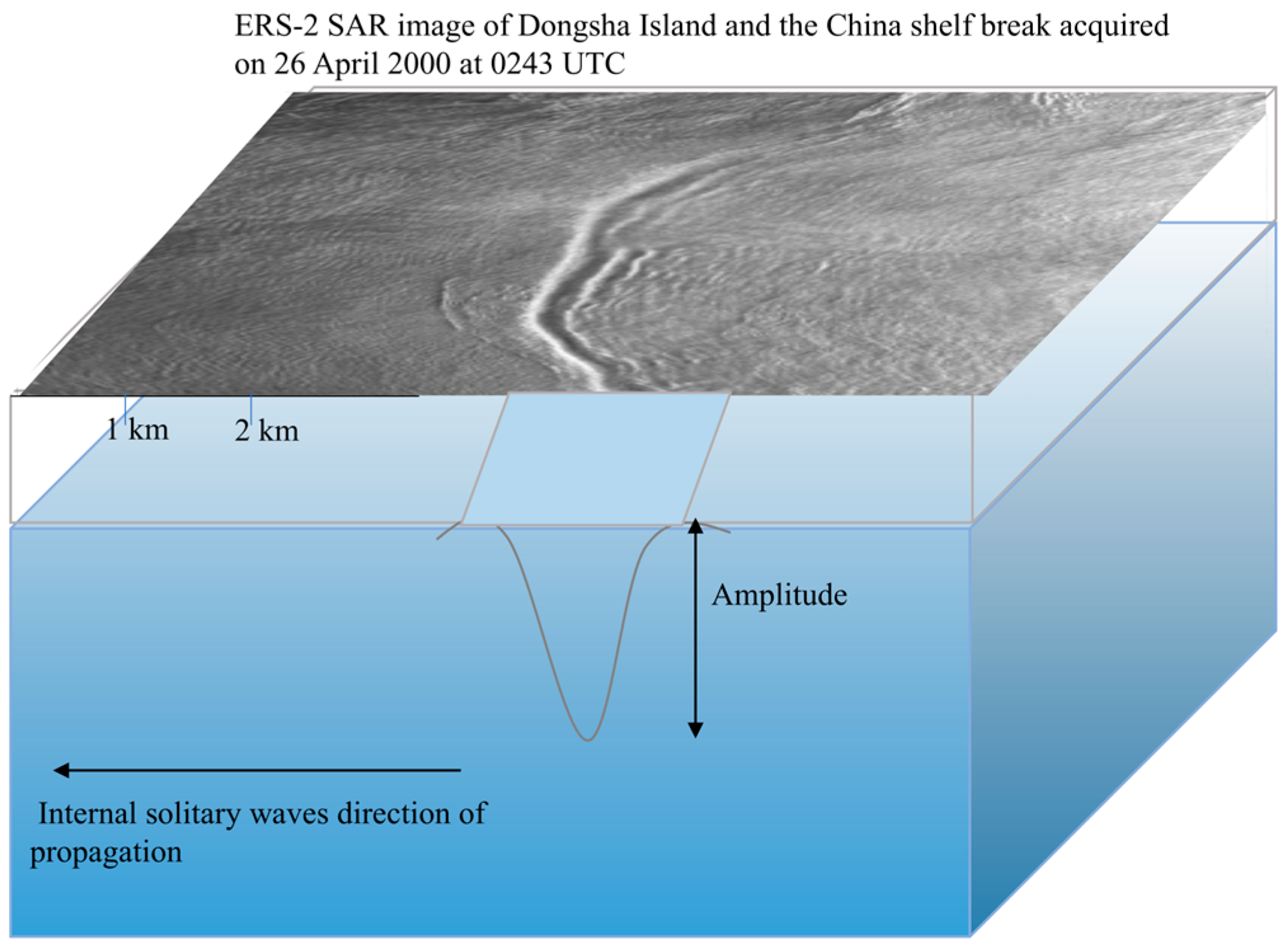

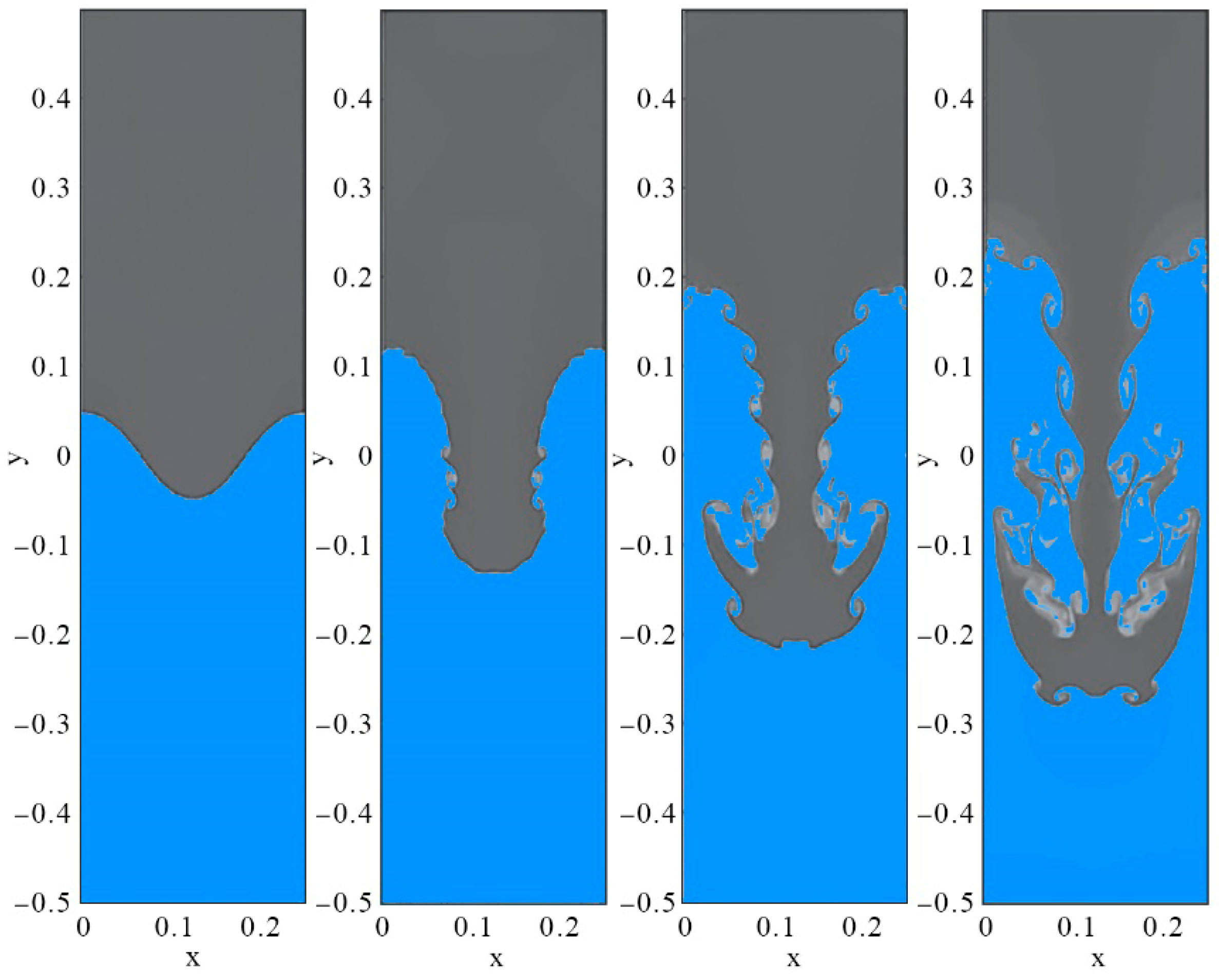
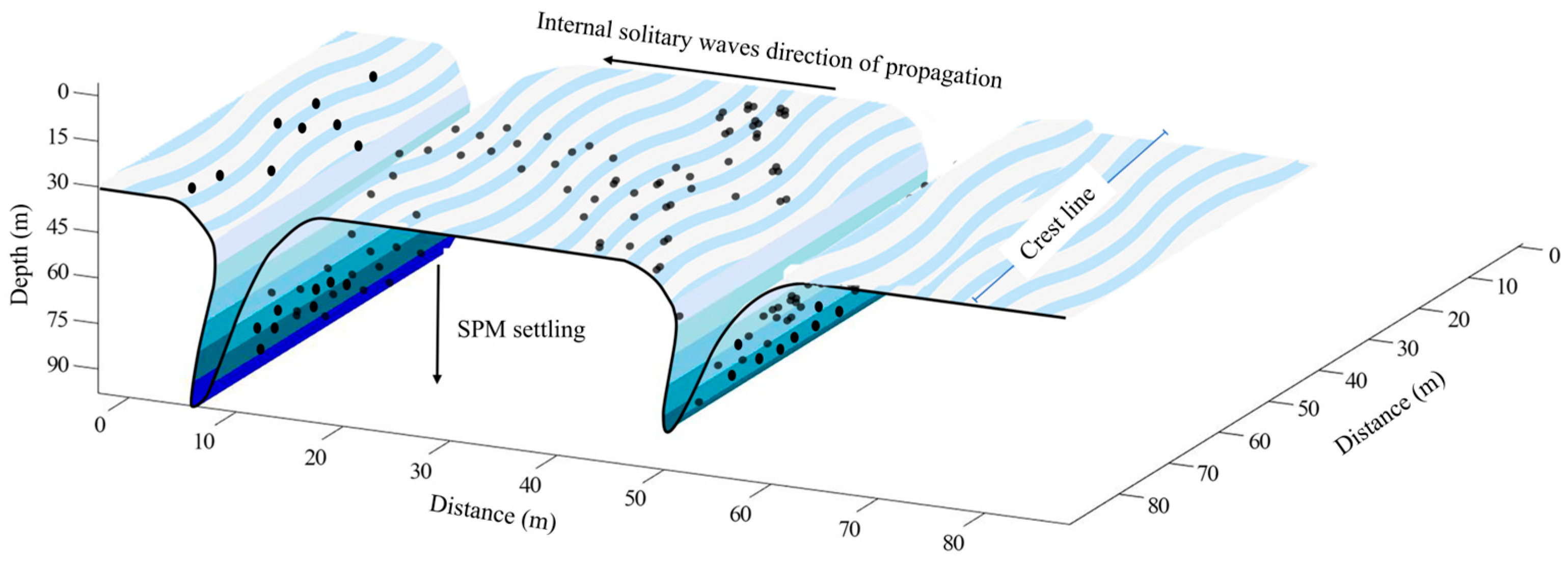
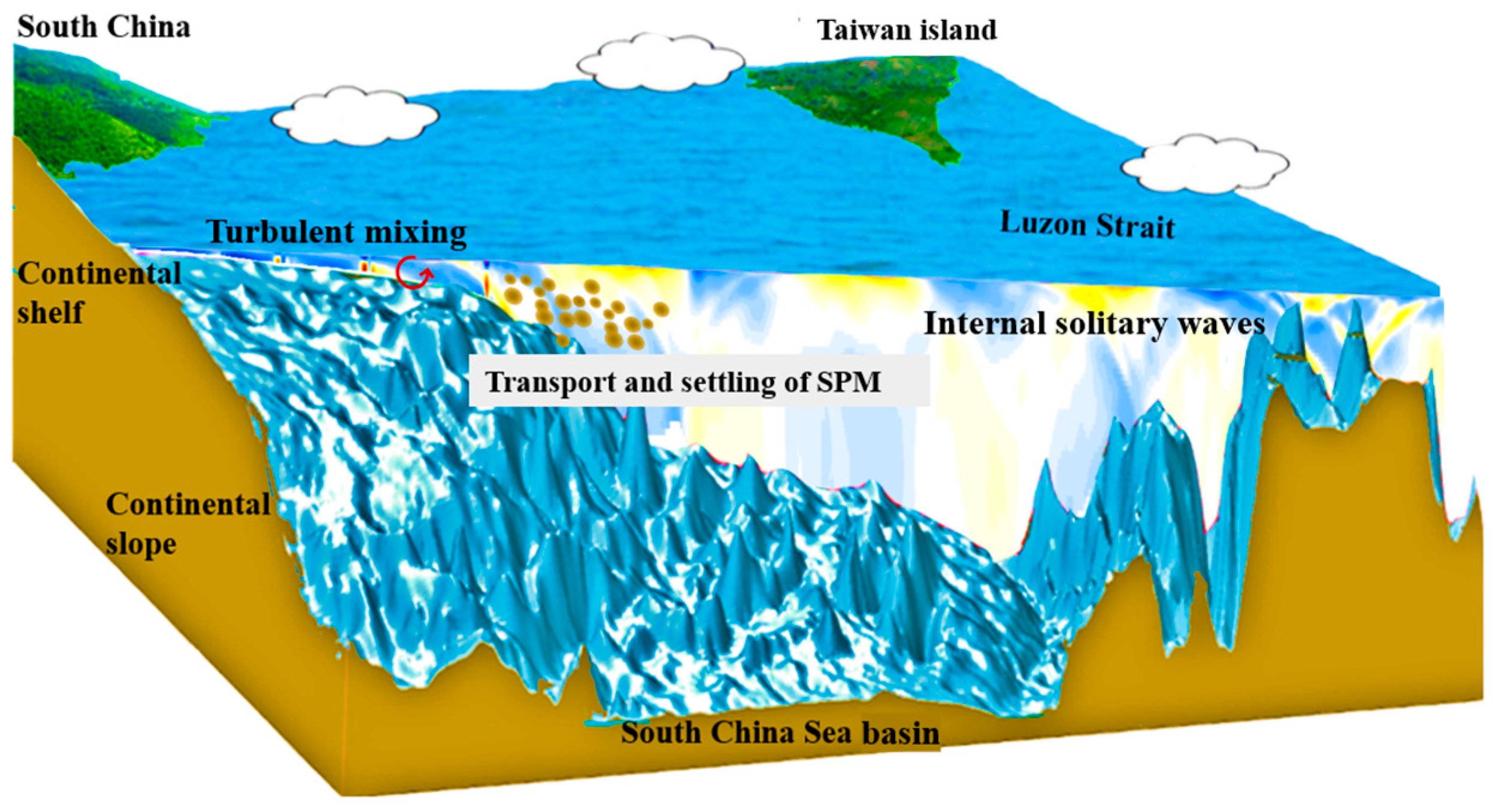
Disclaimer/Publisher’s Note: The statements, opinions and data contained in all publications are solely those of the individual author(s) and contributor(s) and not of MDPI and/or the editor(s). MDPI and/or the editor(s) disclaim responsibility for any injury to people or property resulting from any ideas, methods, instructions or products referred to in the content. |
© 2025 by the authors. Licensee MDPI, Basel, Switzerland. This article is an open access article distributed under the terms and conditions of the Creative Commons Attribution (CC BY) license (https://creativecommons.org/licenses/by/4.0/).
Share and Cite
Zhang, Z.; Feng, X.; Fan, X.; Lin, Y.; Zhu, C. Impact of Internal Solitary Waves on Marine Suspended Particulate Matter: A Review. J. Mar. Sci. Eng. 2025, 13, 1433. https://doi.org/10.3390/jmse13081433
Zhang Z, Feng X, Fan X, Lin Y, Zhu C. Impact of Internal Solitary Waves on Marine Suspended Particulate Matter: A Review. Journal of Marine Science and Engineering. 2025; 13(8):1433. https://doi.org/10.3390/jmse13081433
Chicago/Turabian StyleZhang, Zhengrong, Xuezhi Feng, Xiuyao Fan, Yuchen Lin, and Chaoqi Zhu. 2025. "Impact of Internal Solitary Waves on Marine Suspended Particulate Matter: A Review" Journal of Marine Science and Engineering 13, no. 8: 1433. https://doi.org/10.3390/jmse13081433
APA StyleZhang, Z., Feng, X., Fan, X., Lin, Y., & Zhu, C. (2025). Impact of Internal Solitary Waves on Marine Suspended Particulate Matter: A Review. Journal of Marine Science and Engineering, 13(8), 1433. https://doi.org/10.3390/jmse13081433






